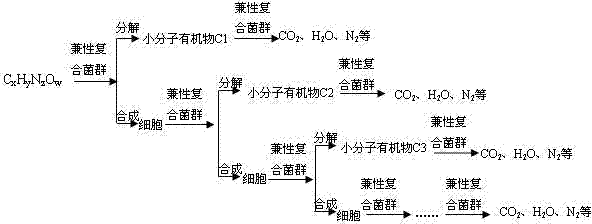Method for synchronously degrading carbon, nitrogen and phosphorus in wastewater without discharging sludge
A technology for degrading sewage and sewage, applied in water/sludge/sewage treatment, adjustment methods for biological treatment, chemical instruments and methods, etc. It can improve the adaptability and treatment efficiency, avoid the risk of secondary pollution, and overcome the difficulty of implementation.
- Summary
- Abstract
- Description
- Claims
- Application Information
AI Technical Summary
Problems solved by technology
Method used
Image
Examples
Embodiment 1
[0012] A facultative or anoxic state is formed in the reactor of the present invention, and the bacteria group in the reactor converts the organic matter in the sewage into carbon dioxide and water and other substances through self-metabolism, and at the same time, the decaying bacteria are decomposed as a nutrient source for other bacteria, and the reaction The organic sludge in the device reaches a dynamic balance, and realizes near-zero discharge of organic excess sludge. The reaction process is shown in the attached drawing of the manual:
[0013] A facultative or anoxic state is formed in the reactor of the present invention. The flora in the reactor converts the phosphorus in the sewage into substances in the microorganisms through self-metabolism, and then converts it into phosphine and biphosphine through a biological cycle. The reaction process is as follows:
[0014] C source + phosphate + facultative complex flora → microbial cells (organophosphate)
[0015] Microbi...
Embodiment 2
[0021] Taking the treatment of a rural sewage (domestic sewage + livestock and poultry wastewater mixed discharge) as an example, the influent BOD 5 The COD is 410mg / L, the COD is 609mg / L, the ammonia nitrogen is 20.96mg / L, and the total phosphorus is 4.10mg / L. After the sewage is pretreated, it directly enters the facultative membrane bioreactor. The process runs continuously and does not discharge sludge . Sewage is treated in a facultative membrane bioreactor (FMBR). During the process, the organic load of the reactor is increased (supplementary carbon source) by not discharging organic sludge, and the parameters of the membrane bioreactor are controlled to form a facultative state. In the facultative membrane bioreactor The reactor (FMBR) synchronously treats sewage sludge and removes nitrogen and phosphorus. Organic pollutants are finally discharged into the air in the form of carbon dioxide, nitrogen, phosphine and biphosphine gas, and BOD in the effluent 5 The COD is 1...
PUM
 Login to View More
Login to View More Abstract
Description
Claims
Application Information
 Login to View More
Login to View More - R&D
- Intellectual Property
- Life Sciences
- Materials
- Tech Scout
- Unparalleled Data Quality
- Higher Quality Content
- 60% Fewer Hallucinations
Browse by: Latest US Patents, China's latest patents, Technical Efficacy Thesaurus, Application Domain, Technology Topic, Popular Technical Reports.
© 2025 PatSnap. All rights reserved.Legal|Privacy policy|Modern Slavery Act Transparency Statement|Sitemap|About US| Contact US: help@patsnap.com

